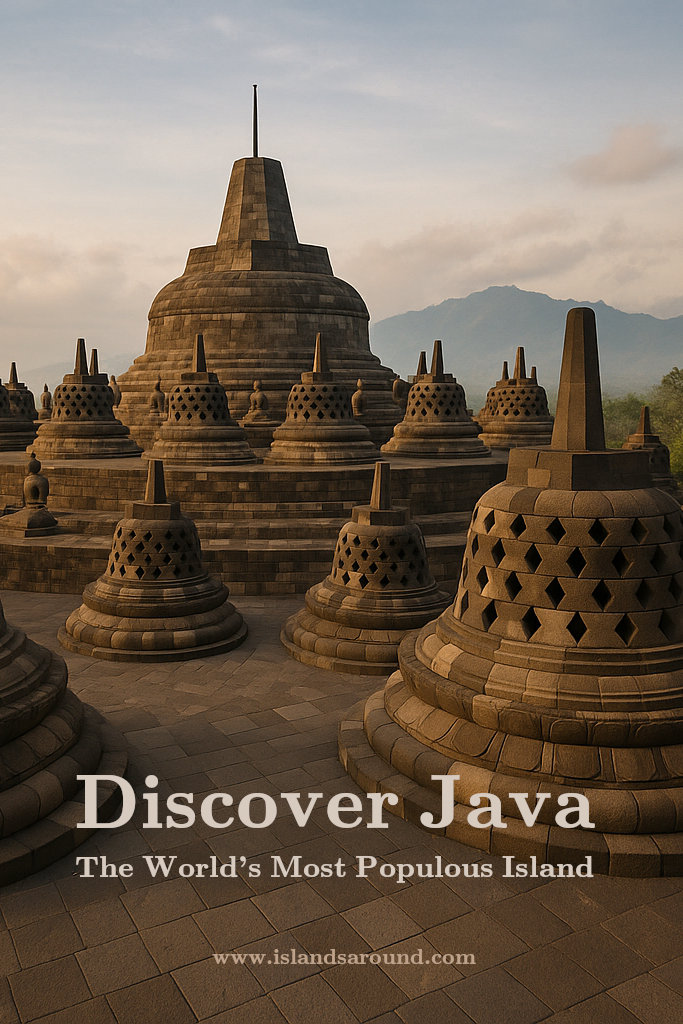The island of Java, Indonesia’s political, economic, and cultural heartland, is home to 153,825,205 people as of 2024, making it the most populous island in the world.
It is a place where ancient traditions intersect with modernity, where megacities hum with activity alongside centuries-old temples, and where history has shaped not just Indonesia but also the course of global trade and politics. Beyond its numbers, Java’s significance lies in its layered history, rich cultural expressions, and dynamic society.
Table of Contents
A Land of People and Movement
The sheer density of Java’s population is staggering. Though it makes up only about 7% of Indonesia’s landmass, it houses over half of the country’s inhabitants.
The island’s urban centers, particularly Jakarta, Bandung, Surabaya, and Yogyakarta, are hubs of commerce and governance, yet a significant portion of the population still resides in smaller towns and rural areas, where agriculture—particularly rice cultivation—remains a way of life.
Jakarta, Indonesia’s capital, exemplifies the rapid urbanization that has defined Java in the past century.

Located on Java’s northwestern coast, the city is a patchwork of towering skyscrapers, sprawling markets, and densely packed kampungs (neighborhoods), illustrating the social and economic diversity of the island.
Further east, Surabaya, the country’s second-largest city, serves as an economic engine, with its thriving port connecting Java to the rest of the archipelago and beyond.
Meanwhile, Yogyakarta and Solo, known for their preservation of Javanese traditions, offer a counterpoint to the modernity of the island’s megacities, where classical Javanese arts and crafts still flourish.

A History Written in Stone and Blood
Java’s history is deeply intertwined with the rise and fall of powerful kingdoms, colonial rule, and the struggle for independence. The island was home to some of Southeast Asia’s most influential empires, including the Srivijaya, Majapahit, and Mataram kingdoms, which left behind monumental structures that continue to shape Javanese identity today.
The 9th-century Borobudur, the world’s largest Buddhist temple, stands as a testament to the artistic and spiritual achievements of Java’s past.

Just a short journey away, Prambanan, a towering Hindu temple complex, reflects the region’s deep connections with Indian culture.
These sites serve as reminders of a time when Java was a center of intellectual and artistic development, attracting scholars, traders, and pilgrims from across Asia. The arrival of Islam in the 15th century transformed Java’s religious and cultural landscape.
The spread of the faith was facilitated by traders from the Middle East and South Asia, as well as by the influential Wali Songo, nine revered Muslim saints who played a crucial role in converting the local population.
Today, Java is predominantly Muslim, though elements of Hindu-Buddhist traditions persist in cultural rituals, art, and architecture. The colonial era ushered in yet another transformation. The Dutch, who arrived in the early 17th century, exploited Java’s fertile land for cash crops such as coffee, sugar, and tea.
The island became the center of Dutch colonial rule in Indonesia, with Batavia (now Jakarta) serving as the capital of the Dutch East Indies. This period saw the rise of nationalism, culminating in Indonesia’s declaration of independence in 1945.
Java was the stage for key moments in this struggle, from student-led movements to armed conflicts that ultimately led to the country’s sovereignty.

Cultural Dynamism: Between Tradition and Innovation
Java’s cultural identity is a dynamic fusion of old and new, where traditional arts continue to thrive alongside contemporary expressions. Wayang kulit (shadow puppetry), gamelan music, and batik textile-making are deeply embedded in Javanese heritage, each carrying symbolic meanings and intricate craftsmanship that have been passed down through generations.
Wayang kulit performances, often based on Hindu epics such as the Ramayana and Mahabharata, are more than mere entertainment; they serve as moral and philosophical reflections on life. Gamelan, an ensemble of percussive instruments, remains a central feature of Javanese music, accompanying ceremonies, dance performances, and even modern experimental compositions.
Batik, a UNESCO-recognized art form, exemplifies Java’s textile heritage. The patterns and motifs in batik fabric are often regionally specific, with Yogyakarta and Solo producing some of the most revered designs. While traditional methods persist, modern designers have adapted batik for contemporary fashion, ensuring its continued relevance.
Beyond these classical arts, Java’s cultural landscape is constantly evolving. The island has given rise to influential writers, filmmakers, and musicians who explore themes of identity, politics, and social change. Indonesian cinema, particularly films produced in Java, has gained international recognition, while musicians blend traditional instruments with modern genres to create new sonic experiences.
The Pulse of Java Today
In the present day, Java faces the challenges and opportunities that come with rapid development. The island’s economic dominance has led to significant infrastructure growth, with high-speed rail projects, expanding highways, and new business hubs reshaping its urban landscapes.
However, this progress has also brought environmental concerns, from deforestation and pollution to the pressures of overpopulation on natural resources. Climate change poses a growing threat, particularly in low-lying areas such as Jakarta, which is sinking at an alarming rate due to groundwater extraction. Plans to move the nation’s capital to Borneo underscore the difficulties of sustaining Java’s intense urbanization.
For those seeking to understand Indonesia, there is no better place to start than Java. Here, history, culture, and modernity exist not as separate entities but as interwoven threads in the fabric of daily life. It is an island that tells the story of a nation, shaped by centuries of movement, migration, and transformation, standing at the crossroads of tradition and the future.

The Five Most Populous Islands in the World
| Rank | Island | Population | Country |
|---|---|---|---|
| 1 | Java | 153 million | Indonesia |
| 2 | Honshu | 104 million | Japan |
| 3 | Great Britain | 65 million | United Kingdom |
| 4 | Luzon | 64 million | Philippines |
| 5 | Sumatra | 60 million | Indonesia |

